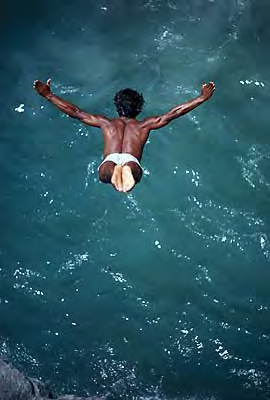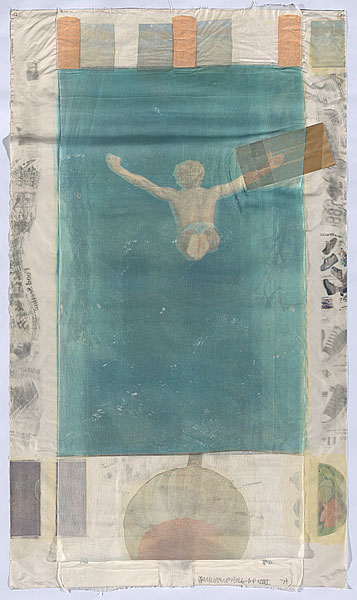Beebe v. Rauschenberg and Artists’ Rights
The story of Morton Beebe’s landmark lawsuit against Robert Rauschenberg concerning artists’ rights.
In November 1976, as Morton Beebe was reading a Time magazine cover story on Robert Rauschenberg, he was astonished to find one of his photographs incorporated in a Rauschenberg print. The image, Mexico Diver, was of a young local performing a swan dive off the Acapulco coast into a deep-blue Pacific Ocean. As a lifelong Nikon shooter, Beebe’s image had previously appeared in a number of magazine advertisements for the legendary camera company.
The print, entitled Pull, was created by Rauschenberg at the Los Angeles graphics house Gemini G.E.L. in 1974, as part of the Hoarfrost series. The mixed-media work, which Rauschenberg referred to as a combine, featured pieces of fabric, cheesecloth, and silk taffeta, together with a silkscreen of Beebe’s image in the center. The border included other printed images, along with a small paper bag glued to overlap part of Beebe’s photo.
As John Henry Merryman and Albert Edward Elsen write in their book Law, Ethics, and the Visual Arts:
Beebe was particularly upset by this unauthorized use of his copyrighted image because he knew that Rauschenberg was a leader in the artists’ rights movement who had devoted time and effort to bringing the needs of artists to the attention of legislators, the media, and the public. Among the causes Rauschenberg has most ardently espoused is the controversial proceeds right, sometimes called the artists’ royalty which gives artists a portion of the money realized when their works are resold at a profit.
Looking for an amicable solution, Beebe wrote a cordial (if not flattering) letter to Rauschenberg, dated January 4, 1977.
Der Mr. Rauschenberg:
Imitation is the height of flattery. In seeing the outstanding cover story on you in Time Magazine of November 29, 1976, I noticed, as did a number of my friends, a remarkable similarity between the reproduction of your original piece of art, entitled "PULL, 1974," of a diver vanishing into a pool. There is a remarkable resemblance to a photograph of mine of a Mexican diver plunging off a cliff in Acapulco, copyrighted in 1972, and published as a portfolio of my work by Nikon, the camera company. It's remarkable that the image of the boy diving superimposed over the reproduction in Time Magazine match perfectly on a light box. Here enclosed is a copy of the Nikon advertisement of the time.
I have admired your work, in fact while in New York in November I flew down to Washington to see the Museum of Fine Arts' One Man Show, of your handsome composites, prints and sculptures. You having been in the lead of protecting artists rights, I was stunned to see one of my images so obviously borrowed without recognition. It is much to your credit to have developed a program of building royalties into sales contracts for artists.
I would appreciate hearing from you on this matter. When next in New York this spring I hope we shall have a chance to meet. We have friends in common.
Best wishes for a happy new year.
Morton Beebe
Seemingly caught off-guard, Rauschenberg responded with a similarly cordial letter, dated January 27, 1977.
Dear Mr. Beebe,
I was surprised to read your reaction to the imagery I used in "Pull", 1974. Having used collagein my work since 1949, I have never felt that I was infringing on anyone's rights as I have consistently transformed these images sympathetically with the use of solvent transfer, collage and reversal as ingredients in the compositions which are dependent on reportage of current events and elements in our current environment hopefully to give the work the possibility of being reconsidered and viewed in a totally new concept.
I have received many letters from people expressing their happiness and pride in seeing their images incorporated and transformed in my work. In the past, mutual admiration has led to lasting friendships and, in some cases, have led directly to collaboration, as was the case with Cartier Bresson. I welcome the opportunity to meet you when you are next in New York City. I am traveling a great deal now and, if you would contact Charles Yoder, my curator, he will be able to tell you when a meeting can be arranged.
Wishing you continued success,
Sincerely Robert Rauschenberg
Merryman and Elsen pick up the story, again from the book Law, Ethics, and the Visual Arts:
Five months later, in June 1977, Rauschenberg was in San Francisco for the opening of an exhibition of his work and Beebe met him at a party. They discussed the issue, but nothing concrete came of their talk, and eventually Beebe retained an attorney, and brought suit against Rauschenberg and Gemini G.E.L. for copyright infringement. He asked for a minimum of $10,000 in damages, plus attorney’s fees and court costs, and the profits from the sale of Pull.
Ultimately, the case was settled out of court with Beebe accepting $3000 (to cover legal expenses) along with an edition of the Pull combine. Most importantly to Beebe, , Rauschenberg and Gemini committed to requesting that any future exhibitor of Pull add the following credit to the accompanying catalog: “the image of the Diver in Pull is after a photograph by Morton Beebe.”
Though less than his initial request for damages, Beebe was satisfied, noting that, “any appearance of the piece will have to have proper recognition on it, and that’s the important thing.”
Beebe’s action against Rauschenberg joins similarly famous copyright cases including three infringement lawsuits by Patricia Caulfield, Fred Ward and Charles Moore against Andy Warhol in the 1960s — all three were settled out of court.
For Beebe, it was a simple question of fairness and artist’s rights, saying “I considered it a victory for myself and for photographers.”
For more information
To learn more about this case and others related to art appropriation, you can read the following:
- No longer appropriate? by Laura Gilbert in The Art Newspaper
- Beebe v. Rauschenberg, The First Big Appropriation Lawsuit by Greg Allen in greg.org
- Beebe v. Rauschenberg: Declaring ‘Victory’ by Greg Allen in greg.org
- Rights as a Creator (email) by Morton Beebe, as archived on The White House web site.
- Transmuting Forms, Click by Click: The Photographer in Robert Rauschenberg by Philip Gefter in The New York Times


